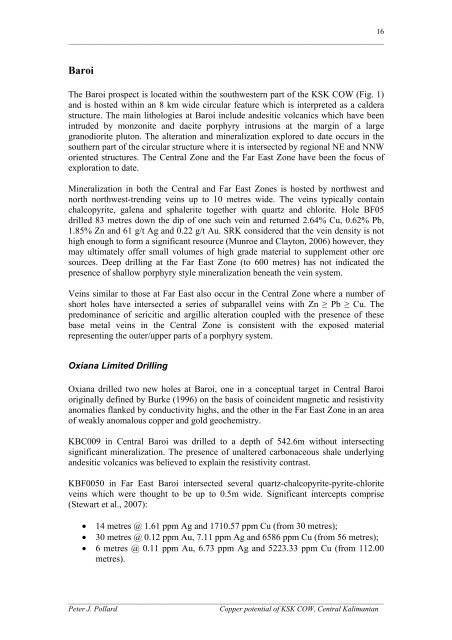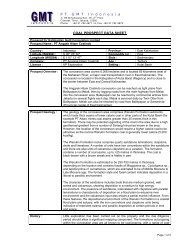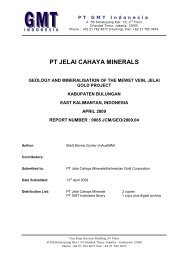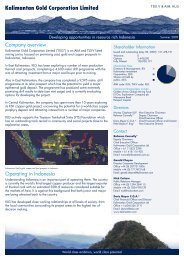Copper potential of KSK COW - Kalimantan Gold Corporation Limited
Copper potential of KSK COW - Kalimantan Gold Corporation Limited
Copper potential of KSK COW - Kalimantan Gold Corporation Limited
Create successful ePaper yourself
Turn your PDF publications into a flip-book with our unique Google optimized e-Paper software.
16<br />
___________________________________________________________________________________<br />
Baroi<br />
The Baroi prospect is located within the southwestern part <strong>of</strong> the <strong>KSK</strong> <strong>COW</strong> (Fig. 1)<br />
and is hosted within an 8 km wide circular feature which is interpreted as a caldera<br />
structure. The main lithologies at Baroi include andesitic volcanics which have been<br />
intruded by monzonite and dacite porphyry intrusions at the margin <strong>of</strong> a large<br />
granodiorite pluton. The alteration and mineralization explored to date occurs in the<br />
southern part <strong>of</strong> the circular structure where it is intersected by regional NE and NNW<br />
oriented structures. The Central Zone and the Far East Zone have been the focus <strong>of</strong><br />
exploration to date.<br />
Mineralization in both the Central and Far East Zones is hosted by northwest and<br />
north northwest-trending veins up to 10 metres wide. The veins typically contain<br />
chalcopyrite, galena and sphalerite together with quartz and chlorite. Hole BF05<br />
drilled 83 metres down the dip <strong>of</strong> one such vein and returned 2.64% Cu, 0.62% Pb,<br />
1.85% Zn and 61 g/t Ag and 0.22 g/t Au. SRK considered that the vein density is not<br />
high enough to form a significant resource (Munroe and Clayton, 2006) however, they<br />
may ultimately <strong>of</strong>fer small volumes <strong>of</strong> high grade material to supplement other ore<br />
sources. Deep drilling at the Far East Zone (to 600 metres) has not indicated the<br />
presence <strong>of</strong> shallow porphyry style mineralization beneath the vein system.<br />
Veins similar to those at Far East also occur in the Central Zone where a number <strong>of</strong><br />
short holes have intersected a series <strong>of</strong> subparallel veins with Zn ≥ Pb ≥ Cu. The<br />
predominance <strong>of</strong> sericitic and argillic alteration coupled with the presence <strong>of</strong> these<br />
base metal veins in the Central Zone is consistent with the exposed material<br />
representing the outer/upper parts <strong>of</strong> a porphyry system.<br />
Oxiana <strong>Limited</strong> Drilling<br />
Oxiana drilled two new holes at Baroi, one in a conceptual target in Central Baroi<br />
originally defined by Burke (1996) on the basis <strong>of</strong> coincident magnetic and resistivity<br />
anomalies flanked by conductivity highs, and the other in the Far East Zone in an area<br />
<strong>of</strong> weakly anomalous copper and gold geochemistry.<br />
KBC009 in Central Baroi was drilled to a depth <strong>of</strong> 542.6m without intersecting<br />
significant mineralization. The presence <strong>of</strong> unaltered carbonaceous shale underlying<br />
andesitic volcanics was believed to explain the resistivity contrast.<br />
KBF0050 in Far East Baroi intersected several quartz-chalcopyrite-pyrite-chlorite<br />
veins which were thought to be up to 0.5m wide. Significant intercepts comprise<br />
(Stewart et al., 2007):<br />
• 14 metres @ 1.61 ppm Ag and 1710.57 ppm Cu (from 30 metres);<br />
• 30 metres @ 0.12 ppm Au, 7.11 ppm Ag and 6586 ppm Cu (from 56 metres);<br />
• 6 metres @ 0.11 ppm Au, 6.73 ppm Ag and 5223.33 ppm Cu (from 112.00<br />
metres).<br />
___________________________________________________________________________________<br />
Peter J. Pollard<br />
<strong>Copper</strong> <strong>potential</strong> <strong>of</strong> <strong>KSK</strong> <strong>COW</strong>, Central <strong>Kalimantan</strong>










